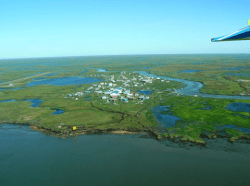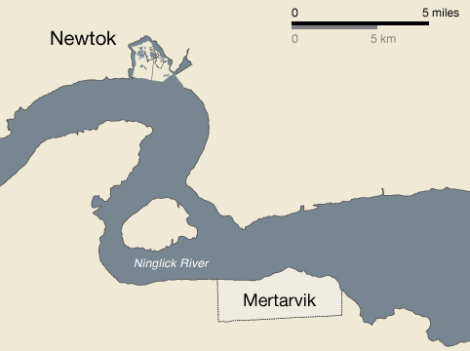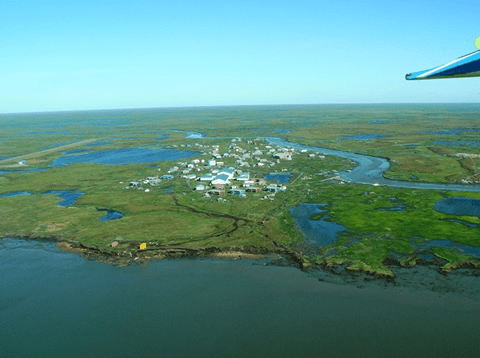This story is part of a Guardian series on climate refugees. Read part 1.

Climate Adaptation Knowledge Exchange (2011)Newtok.
It’s easy to see the appeal for Lisa and Jeff Charles of being at the forefront of the Alaskan village of Newtok’s move to a new location.
The couple, who have six young children, were allotted one of the first houses in Mertarvik — as the villagers call the chosen relocation site — nine miles south of Newtok on Nelson Island.

The house allotted to the Charles family was hardly palatial: 1,350 square feet on a single level with an open-plan kitchen and living area, four bedrooms, and one bathroom.
But it’s twice as big as the place Jeff built when he was 21, adding on two rooms after he married Lisa and their household grew to six children under the age of 12, a chihuahua, and a couple of puppies. There is no running water so the family use a big plastic barrel in the kitchen to store water.
The new house, fitted with wood panelling and new appliances, sits on a high ridge of volcanic rock and is flooded with light. It is supposed to have flush toilets when it is complete, unlike their current home. “This place feels maybe like a mansion compared to our other house,” said Lisa. “We can’t wait to move across.”
And they didn’t. The family began setting up home last summer before the work crews were done. The two older children chose their bedrooms, the first time they had rooms of their own. Lisa began thinking about where to set up a rack for drying fish in the summer time, and moved a television and futon sofa into the living room.
On sunny days, the family looked out the front window to watch seals bobbing in the water below. One day Lisa looked out the kitchen window, which faces the rear of the house, to see 14 muskox grazing among the willow trees. “It was pretty nice,” she said.
If she hadn’t had a newborn baby last summer, Lisa said she would have stayed in her new home throughout the past winter — despite the extreme isolation.
Once the river freezes, the island is accessible only by snowmobile. The family would have been virtually alone at the new site. A tribal elder did attempt to winter in Mertarvik, but he was forced to leave when he ran low on heating oil.
But Lisa was willing to entertain the idea of sticking it out. She even spoke with the school principal about bringing homework for the older children so they would not fall behind.
Their house was one of three that went up last summer — the first stage in a painfully slow process of finding the funds to move the 63 dwellings in the existing village.
Their house back in Newtok sits well back of the area most threatened by the river. But when the village floods, as it does most years during break-up, the water washes up to within 20 feet of their house, stinking of sewage and waste. The higher ground and hard rock of Mertarvik would be a lot cleaner, and a healthier place to live.
If she had her way, Lisa Charles would be back with her family as soon as the ice breaks this summer, maybe this time for good. “I’m not 100 percent sure but that would be nice, if we could maybe go back and forth,” she said.
The older children might miss their friends at school though. Her eldest daughter, Ashley, is in basketball and other teams that compete with nearby villages.
But Lisa said she is ready to leave Newtok behind. “I’ll miss the village when it’s gone,” she said. “But everyone will be living across there. It will look different, but it will still have the same people.”
Next: Can a baked Alaska deny climate change?
 This feature originally appeared on the Guardian website as part of the Climate Desk collaboration.
This feature originally appeared on the Guardian website as part of the Climate Desk collaboration.




